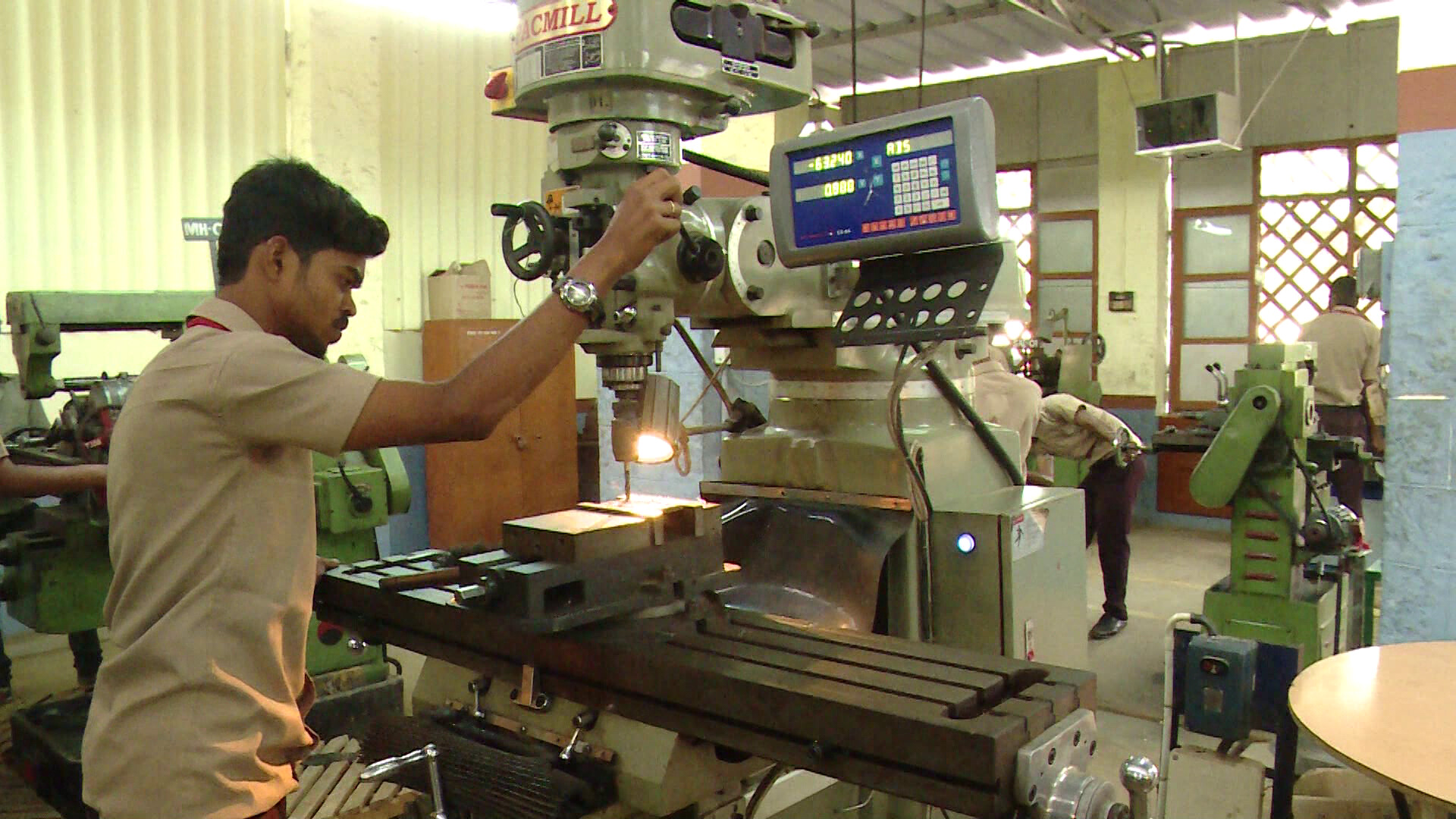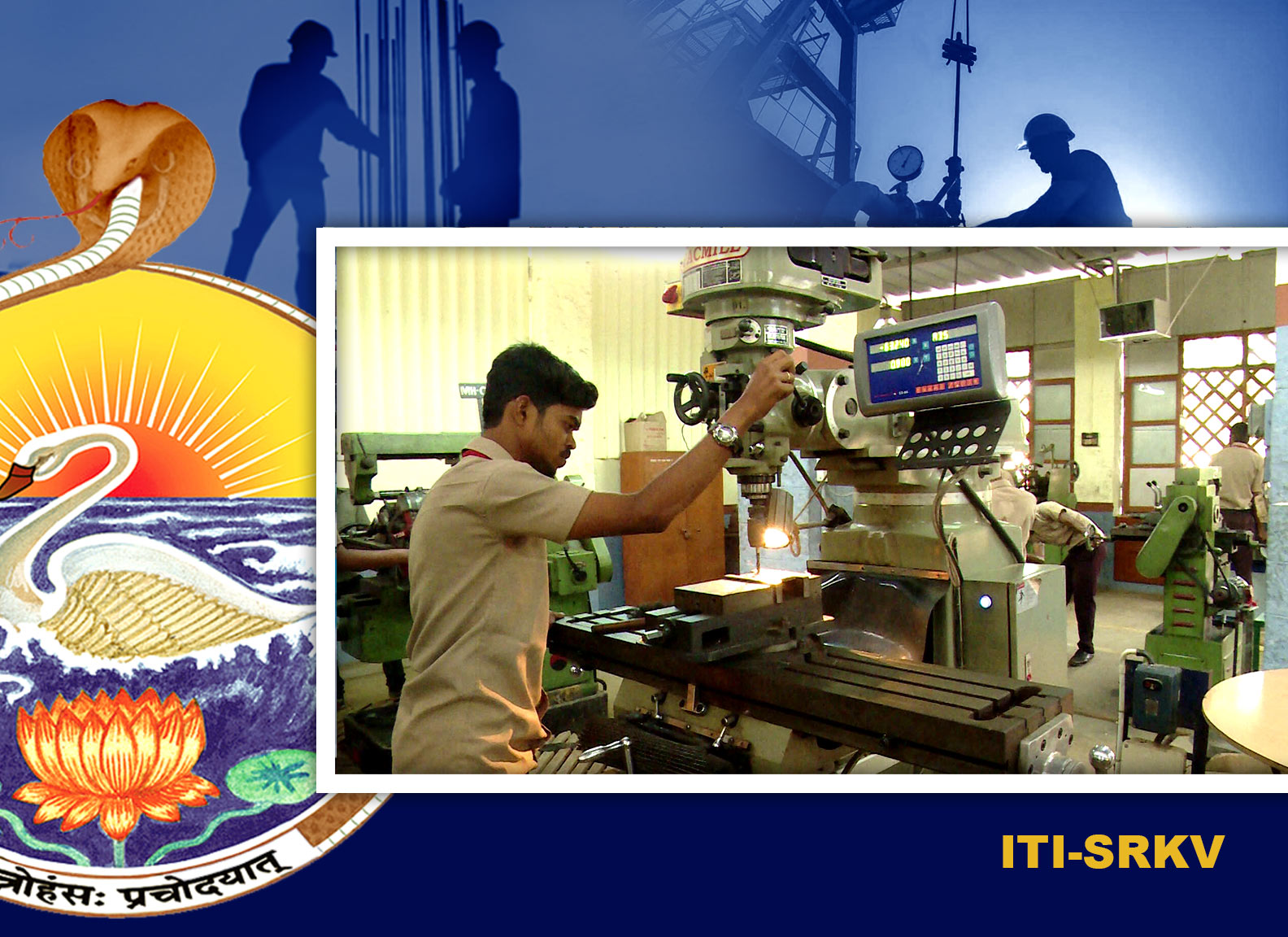Trade Machinist
Knowledge in various operation in shaping, planning, slotting, milling and gang milling machines like setting job, tools, speed read on shaper, setting of stroke, cut slots, key ways and curves. Drilling operations on pillar drill, Cut spline – internal and external gears and sprocket on a slotter. Simple programming and operation on CNC are imparted in this trade.
MACHINIST – LEARNING OUTCOMES
 FIRST YEAR
FIRST YEAR
1. Plan and organize the work to make job as per specification applying different types of basic fitting operation and check for dimensional accuracy following safety precautions. [Basic fitting operation – marking, Hack sawing, Chiselling, Filing, Drilling, Taping and Grinding etc. Accuracy: ± 0.25mm]
2. Produce components by different operations and check accuracy using appropriate measuring instruments.[Different Operations – Drilling, Reaming, Tapping, Dieing; Appropriate Measuring Instrument – Vernier, Screw Gauge, Micrometer]
3. Make different fit of components for assembling as per required tolerance observing principle of interchangeability and check for functionality. [Different Fit – Sliding, Angular,
Step fit, ‘T’ fit, Square fit and Profile fit; Required tolerance: ±0.2 mm, angular tolerance: 1 degree.]
4. Set different shaped jobs on different chuck and demonstrate conventional lathe machine operation observing standard operation practice. [Different chucks: 3 jaws & 4 jaws, different shaped jobs: round, square, hexagonal]
5. Prepare different cutting tool to produce jobs to appropriate accuracy by performing different turning operations. [Different cutting tool – V tool, side cutting, parting, thread cutting (both LH & RH), Appropriate accuracy: – ±0.06mm, Different turning operation – Plain, facing, drilling, boring (counter & stepped), grooving, Parallel Turning, Step Turning, parting, chamfering, U -cut, Reaming, knurling.]
6. Set different components of machine & parameters to produce taper/ angular components and ensure proper assembly of the components. [Different component of machine: Form tool, Compound slide, tail stock offset; Different machine parameters- Feed, speed, depth of cut.]
7. Set the different machining parameters to produce metric-v threaded components applying method/ technique and test for proper assembly of the components.
8. Set the different machining parameters and cutting tool to prepare job by performing different slotting operation. [Different machining parameters – feed, speed and depth of cut. Different slotting operations–concave & convex surface, internal key ways, profiling, making internal sprocket with an accuracy of +/- 0.04 mm]
9. Set the different machining parameters and cutters to prepare job by performing different milling operation and indexing. [Different machining parameters – feed, speed and depth of cut. Different milling operations – plain, face, angular, form, gang, straddle milling]
10. Set the different machining parameters to produce square & “V’’ threaded components applying method/ technique and test for proper assembly of the components.
11. Produce components of high accuracy by different operations using grinding. [Different operations – surface grinding, cylindrical grinding with an accuracy of+/- 0.01 mm]
SECOND YEAR
12. Re-sharpen different single & multipoint cutting tool. [Different single point tools, slab milling cutter, side & face milling cutter, end mill cutter and shell end mill cutter.]
13. Set different machining parameters and cutters to prepare job by different milling machine operations. [Different machining parameters – feed, speed, depth of cut, different machining operation – facing, drilling, tapping, reaming, counter boring, counter sinking, spot facing, and boring slot cutting.]
14. Set the different machining parameters and cutters to prepare components by performing different milling operation and indexing. [Different machining parameters – feed, speed and depth of cut. Different components – Rack, Spur Gear, External Spline, Steel Rule, Clutch, Helical Gear]
15. Identify and explain basic functioning of different electrical equipment, sensors and apply such knowledge in industrial application including basic maintenance work. [Different electrical equipment- multi-meter, transformer, relays, solenoids, motor & generator; different sensors –proximity & ultrasonic.]
16. Set (both job and tool) CNC turning centre and produce components as per drawing by preparing part programme.
17. Set CNC VMC (Vertical Machining Center) and produce components as per drawing by preparing part programme.
18. Plan and perform simple repair, overhauling of different machines and check for functionality. [Different Machines – Drilling Machine, milling machine and Lathe]
19. Set the different machining parameters and cutters to prepare components by performing different milling operation and indexing. [Different machining parameters – feed, speed and depth of cut. Different components – end mill, bevel gear, cam, worm & worm wheel]

MACHINIST CAREER PROGRESSION PATHWAYS – ITI
Can join industry as Technician and will progress further as Senior Technician, Supervisor and can rise up to the level of Manager.
Can appear in 10+2 examination through National Institute of Open Schooling (NIOS) for acquiring higher secondary certificate and can go further for General/ Technical education.
Can take admission in diploma course in notified branches of Engineering by lateral entry.
Can join Apprenticeship programme in different types of industries leading to National Apprenticeship certificate (NAC).
Can join Crafts Instructor Training Scheme (CITS) in the trade for becoming instructor in ITIs.
Can join Advanced Diploma (Vocational) courses under DGT as applicable.
MACHINIST JOB ROLE
operates various types of power driven metal cutting or grinding machines for cutting and grinding metal. Studies drawings or measures out sample with appropriate measuring instruments to note different dimensions and sequence of operations required. Selects metal piece and marks it or gets it marked for machining operations required. Fastens metal in chuck, jig or other fixture and respective tool or cutter, according to sequence of operation, on appropriate machine (lathe, shaper, milling, slotting, drilling, grinding).Checks machine setting or sets it for stipulated machine operations. Selects machine feed and speed and starts machine. Controls flow of coolant (cutting lubricant) and manipulates hand wheels or applies automatic controls to feed tool to metal or metal to tool. Observes cutting or grinding both from marking and machine readings, checks for dimensions as necessary and removes parts when machining is completed, checks completed part with measuring instruments and gauges to ensure prescribed accuracy. Makes adjustments if necessary and repeats operations, as required, on same or other machines. May assist in setting up machine for repetitive work, change tools, make simple adjustments, clean and oil machine. Does process planning, tool and cutting parameters selection, programming, setup and operation for cutting parts on CNC vertical machining center and CNC lathe.
Machinist Entry Qualification & Course Durations
• Passed 10th class examination with Science and Mathematics or its equivalent.
• 2 years.













 Ramakrishna Mission Vidyalaya Private Industrial Training Institute, was founded in the year 1951 with the intention of eradicating un-employment among youth, and providing skilled man power to Industries in and around Coimbatore. In a humble way, we started with two trades namely Fitter and Turner with the affiliation and financial support from the Government of Tamilnadu. In the year 1982, a two year course on Draughtsman Mechanical, and Mechanic (Motor Vehicle) was started with the affiliation from National Council for Vocational Training ( NCVT), Government of India. In the same year two year Fitter course got affiliated with NCVT. In the year 1992, a two year course in wireman was started with affiliation from NCVT. In the same year Two year Turner course got affiliated with NCVT. Presently our students’ strength is 200.
Ramakrishna Mission Vidyalaya Private Industrial Training Institute, was founded in the year 1951 with the intention of eradicating un-employment among youth, and providing skilled man power to Industries in and around Coimbatore. In a humble way, we started with two trades namely Fitter and Turner with the affiliation and financial support from the Government of Tamilnadu. In the year 1982, a two year course on Draughtsman Mechanical, and Mechanic (Motor Vehicle) was started with the affiliation from National Council for Vocational Training ( NCVT), Government of India. In the same year two year Fitter course got affiliated with NCVT. In the year 1992, a two year course in wireman was started with affiliation from NCVT. In the same year Two year Turner course got affiliated with NCVT. Presently our students’ strength is 200.